Fast-fold poker has taken the online poker world by storm, offering a turbocharged experience that’s a far cry from the patient grind of traditional cash games. In these hyper-accelerated tables, players move on to new hands the instant they fold, bypassing the wait for the current hand to finish. This single tweak transforms every fold into a fresh opportunity, creating a pulse-pounding rhythm of decision-making that keeps adrenaline levels high. Having logged hundreds of hours across multiple sites testing fast-fold—sometimes up to 200 hands per hour—I can attest that its blend of speed, strategy, and variance makes it one of the most electrifying formats in poker today.
A Brief History of Fast-Fold Poker
The fast-fold concept first gained traction in 2010 when PokerStars introduced Zoom Poker, and it quickly became a hit among players who craved more action. Instead of stuck hands or waiting for all opponents to play out weak hole cards, Zoom instantly reshuffled you into a new seat, ensuring you stayed at tables brimming with strong hands or bluffing opportunities. Within a few years, other operators followed suit, rebranding the format as “Rush & Cash,” “Fast Forward,” and “Snap.” What began as a novelty now accounts for a significant share of ring game traffic on major networks, particularly among grinders and recreational players looking for an electrifying pace.
How Fast-Fold Poker Works
At its core, fast-fold poker retains the same rules as No-Limit Hold’em. Each table has a pool of players rather than fixed seats. You’re dealt two hole cards, action unfolds, and if you fold at any point, you instantly receive two new cards at a different seat, often against completely new opponents. This continuous loop shaves down downtime dramatically. You might face a weak suited connector and fold pre-flop, only to be redealt stronger cards in seconds—no waiting, no downtime, just pure action.
Unlike sit-and-go tournaments or multi-table ring games that can drag on, fast-fold tables are ideal for session-based play. You can make micro-stakes bankroll moves in the morning before work or grind out a solid win rate in the evening—whatever suits your schedule. For many grinders, the ability to accumulate volume quickly is a major draw. After all, poker is a game of edges, and more hands equate to more opportunities to exploit those edges.
Why the Thrill Is Real
There’s something visceral about the pace of fast-fold poker. Every hand feels like a fresh bookmark in your session, and the inability to become bored means mental fatigue creeps in more slowly. Personally, I found that after switching from standard 6-max cash games to fast-fold, I was maintaining focus for longer stretches. Breaking even over 200 hands per hour feels more rewarding than watching a dozen dull hands play through on a static table.
Fast-fold also amplifies the psychological dimension. Players who constantly reshuffle can’t develop long-term reads on their opponents. Even if you identify a fish folding too much a couple of times, they disappear before you can table-scan their tendencies. This forces you to rely on fundamental skills—hand selection, pot odds, and aggression—rather than player history. For those of us who thrive on pure strategy rather than reads, that emphasis on technical play makes each decision deeply engaging.
Finding the Right Platform
When searching for fast-fold games, the platform you choose matters. Beyond software stability and table traffic, look for sites that boast robust player pools and generous rakebacks. One way to narrow your options is by referring to rankings of the best poker sites uk, where experienced players review liquidity, speed, and rewards. High-quality fast-fold tables require a large player base—without it, you risk being seated repeatedly with the same opponents, which dimishes variety and excitement.
Personally, I’ve cycled through several sites over the years, and the best platforms balance anonymous fast-fold tables (to deter collusion) with detailed session tracking. Seeing your hourly hands and win rates mapped out in real time helps adjust your strategy on the fly. As a final tip, always test new providers at micro-stakes first. Ensuring the software runs smoothly on your machine and that there are active games at your preferred limits can save frustration down the road.
Strategy Adjustments for Fast-Fold
Although methods like “facing a 3-bet” or “c-betting flops” remain staples of Hold’em strategy, fast-fold poker demands tweaks. Pre-flop, you can widen your opening range because if you fold, you immediately get fresh cards. Post-flop aggression gains importance too— since reads are limited, stealing down low-action, multi-way pots can be highly profitable. However, be wary: opponents may apply similar looseness, so pot-control and hand-reading still matter.
One personal insight: track your pre-flop and continuation bet frequencies closely. On a regular table, you might remember how many times you folded out opponents or bluffed successfully. In fast-fold, you need HUD data to get those metrics. Reviewing week-long stats can reveal if you’re over-folding to 3-bets or missing value by under-c-betting. These small leaks can add up significantly when you’re seeing 1,000 hands per week.
Bankroll and Bankroll Management
Volume-centric formats like fast-fold can trick you into overestimating your edge because results swing more rapidly. A big upswing over a couple of sessions may not indicate a true positive ROI. When I transitioned to fast-fold, I learned to preserve my bankroll by setting strict stop-loss limits each session. Once I dropped 3 buy-ins in a day, I’d close the tables—regardless of how good I felt in the moment.
Conversely, hitting a big upswing can be addictive. I’ve seen players chase variance by opening additional tables when they’re hot, only to give back winnings when their luck runs cold. Discipline matters more here than in standard rings. The rapid-fire nature means you have to decide in ten seconds whether to open two more tables or pause and analyze your play.
The Social Element
Some players fear that fast-fold poker lacks the camaraderie of a traditional table. Indeed, you’ll rarely exchange chat with the same opponents twice. Yet, many operators now integrate social features—like table chat emojis, shared status bars, and community leaderboards—that let you track your rank against other fast-fold regulars. Personally, I’ve enjoyed comparing weekly WPH (hands per hour) and win rates in public lobbies, which adds a community vibe without slowing down the action.
There’s also a growing trend of fast-fold tournaments, where you compete in sprints rather than long-form events. These micro-tournaments often feature knockout bounties, with each “fallen” opponent boosting your prize pool. They’re the perfect hybrid for players who love fast-fold’s velocity but crave the communal thrill of a knockout format.
Real-World Examples
To illustrate the excitement, let me share two anecdotes. In one session, I folded pre-flop and was instantly redealt pocket Aces. Within a minute, I flopped a set and rivered quads, turning a £0.10 stake into a £150 pot across three tables. That rush is something you rarely experience in standard games because it takes far more time to find those nut moments.
In another scenario, I spotted an opponent 45% fightback frequency in three-way pots but disappearing before showdown. I used that stat to increase my c-bet size, pressure them into folding marginal hands, and exploit the lack of showdown reads. Over 500 hands, that adjustment alone netted me an extra £80—proof that data-driven tweaks pay off quickly when you’re playing in high-volume fast-fold.
Technology Behind the Scenes
Fast-fold poker relies on robust RNG servers and seamless handoff protocols to deal you new cards without noticeable delay. Operators invest heavily in infrastructure: every fold triggers a server call that must populate your next hand in milliseconds. If the software lags, you miss critical decisions or auto-fold inadvertently. Before committing real money, I recommend tracking latencies visually (usually displayed in milliseconds on the client) and ensuring your internet connection is stable.
Mobile adaptations are also improving. While desktop remains the gold standard for multi-tabling, fast-fold on phones and tablets is surprisingly capable. Touchscreen interfaces let you fold with a single tap, and modern apps even support split-screen mode if you want two tables at once. I tested both iOS and Android clients, and the latter’s gesture-based folder won points for speed and reliability.
Fast-Fold vs. Regular Cash Games
A common debate among players is whether fast-fold results translate to standard games. I’ve moved between formats regularly and learned that patience and opponent reads are more critical in regular games. Fast-fold hones your instincts for aggression and pot odds, while traditional tables sharpen your live-reading skills. The best players I know alternate between both formats to develop a balanced skill set and avoid monotony.
Switching back to regular tables after a fast-fold grind can feel like swimming through treacle. You’re accustomed to immediate redeals, and waiting becomes frustrating. Conversely, hopping into fast-fold after a long traditional session feels like rocket fuel—perfect if you need to jumpstart your session with some quick action.
The Future of Fast-Fold Poker
Looking ahead, I anticipate more hybrid models that blend fast-fold’s velocity with enhanced social interactions—perhaps live-streamed fast-fold tables with community chat overlays. We might also see gamified dashboards that reward streaks of profitable decisions rather than chips won alone. As VR poker gains traction, I can imagine a fast-fold VR experience where you “rip” your cards and physically move to a new table in a virtual casino.
Whatever unfolds, one thing is clear: fast-fold poker has permanently reshaped online cash games. Its blend of speed, strategy, and volume offers a unique thrill that continues to captivate players globally.
Conclusion
Fast-fold poker games stand out because they eliminate downtime, emphasize core strategic skills, and deliver high-volume excitement. While they demand disciplined bankroll management and regular strategy tweaks, the adrenaline rush of constant decision-making can’t be matched in traditional cash games. By choosing reputable platforms—like those listed among the best poker sites UK—you’ll find stable software, deep liquidity, and supportive communities to fuel your fast-fold journey. Whether you’re a grinder chasing hourly edges or a recreational player seeking an electrifying challenge, fast-fold poker offers a dynamic, modern twist on a timeless classic.


